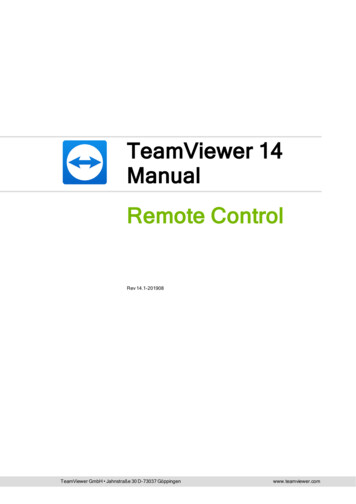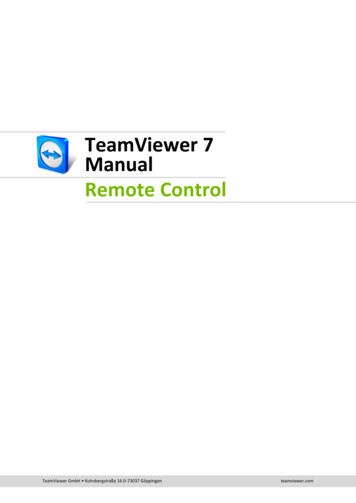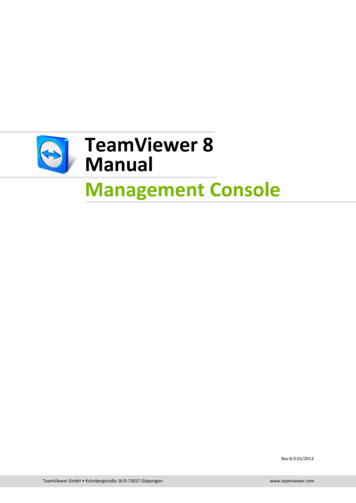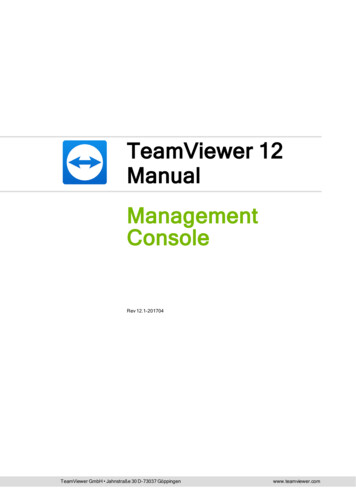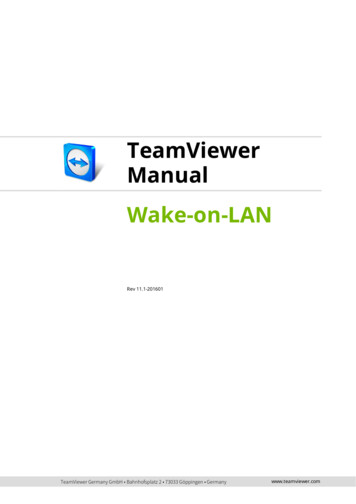
Transcription
TeamViewerManualWake-on-LANRev 11.1-201601TeamViewer Germany GmbH Bahnhofsplatz 2 73033 Göppingen Germanywww.teamviewer.com
Table of contents1About Wake-on-LAN32Requirements53Set up Windows63.1Configure the BIOS63.2Configure the network card73.3Deactivate fast startup84Set up Mac OS X94.1Configure the network card95Configure TeamViewer5.1Assign the computer to your TeamViewer account105.2Wake-on-LAN via a TeamViewer ID in the network115.3Wake-on-LAN via a public address126Wake up the computer147Appendix157.1Configure the routerTeamViewer Manual – Wake-on-LAN1015www.teamviewer.comPage 2 of 16
1 About Wake-on-LAN1About Wake-on-LANYou can turn on an offline computer with TeamViewer via Wake-on-LAN.This way, you can control an offline computer remotely by waking it up before you establish aconnection.Wake-on-LAN can be used through two different methods:lWake up a computer via another computer within the same network (see Section 5.2 ,page 11).TeamViewer Manual – Wake-on-LANwww.teamviewer.comPage 3 of 16
1 About Wake-on-LANlWake up a computer via its public address (see Section 5.3 , page 12).This manual describes the necessary requirements and steps to use TeamViewer Wake-onLAN.Unless stated otherwise, the functionalities described always refer to the TeamViewer fullversion for Microsoft Windows.TeamViewer Manual – Wake-on-LANwww.teamviewer.comPage 4 of 16
2 Requirements2RequirementsIn order to successfully wake up a computer by Wake-on-LAN, its hardware must meet severalrequirements.The following checklist ensures that the computer is suitable for Wake-on-LAN:lThe computer is connected to a power source.lThe computer's network card supports Wake-on-LAN.lThe computer has an Internet connection.lThe computer is connected to the Internet via a network cable.lThe computer is in one of the following power stateslSleepllHibernationllStart SleepStart HibernationShut down (Soft off)lStart Shut down (not supported unter Mac OS X)Supported power states.If these requirements have been met, you can move on to configure your computer and thesoftware in the next steps.TeamViewer Manual – Wake-on-LANwww.teamviewer.comPage 5 of 16
3 Set up Windows3Set up WindowsIn order to wake up the computer, it must be appropriately set up. Several settings must beadjusted on the computer for this purpose and TeamViewer must be correctly configured.3.1Configure the BIOSTo activate Wake-on-LAN in the BIOS, follow these steps:1. Start the computer.2. Press the F2 key (or the equivalent) to access the BIOS set-up.The BIOS set-up will open.3. Open the Power tab.4. Activate the Wake-on-LAN option.5. Save and exit the BIOS set-up.Activating Wake-on-LAN in the BIOS.Note: If there is no option to activate Wake-on-LAN in the BIOS, check the manual of themotherboard to make sure that it supports Wake-on-LAN.TeamViewer Manual – Wake-on-LANwww.teamviewer.comPage 6 of 16
3 Set up Windows3.2Configure the network cardThe computer's network card must be configured in such a way that it is supplied with power atall times. It may be necessary to adjust the properties of the network card for this purpose.Note: Administrative rights are required for this process.Note: Configuration of the network card can vary depending on the type of network cardand operating system version.To activate Wake-on-LAN for the network card under Windows, follow these steps:1. Start the computer.2. Open the Settings.3. Click Devices.4. Under Related settings, click the Device Manager link.The Device Manager window will open.5. Under Network adapters, choose the Properties option in the context menu (rightclick) of the network card.The Properties of network card dialog will open.6. Open the Power Management tab.7. Activate the Allow this device to wake the computer option.8. The network card now supports Wake-on-LAN.Activating Wake-on-LAN for the network card under Windows.Note: If the option described in Step 7 is not activated, you must first activate the Allow thecomputer to turn off the device to save power option.TeamViewer Manual – Wake-on-LANwww.teamviewer.comPage 7 of 16
3 Set up Windows3.3Deactivate fast startupSince Windows 8, the standard shutdown procedure puts the computer into a "hybrid shutdown" state. Because Windows does not support Wake-on-LAN for this state, it is advisable todeactivate the fast startup. Once fast startup has been deactivated, the computer is always putinto hibernation when shutdown.Note: Administrative rights are required for this process.To deactivate the fast startup under Windows, follow these steps:1. Start the computer.2. Open the Control Panel.The Control Panel window will open.3. Click System and Security.4. Under Power Options, click the Change what power buttons do link.5. Click on the Change settings that are currently unavailable link.6. Uncheck the Turn on fast startup (recommended) box.7. Fast startup is now deactivated.Deactivating fast startup under Windows.TeamViewer Manual – Wake-on-LANwww.teamviewer.comPage 8 of 16
4 Set up Mac OS X4Set up Mac OS XThe computer's network card must be configured in such a way that it is supplied with power atall times. It may be necessary to adjust the properties of the network card for this purpose.4.1Configure the network cardTo activate Wake-on-LAN for the network card under Mac OS X, follow these steps:1. Start the Mac.2. Open the System Settings.The System Settings window will open.3. Click Save Energy.4. Click the Power Supply tab.5. Activate the Wake for Wi-Fi network access option.6. The network card now supports Wake-on-LAN.Activating Wake-on-LAN for the network card under Mac OS X.TeamViewer Manual – Wake-on-LANwww.teamviewer.comPage 9 of 16
5 Configure TeamViewer5Configure TeamViewerIn order to wake up a computer, TeamViewer must be configured once on this device. Duringthis process, you can either configure TeamViewer so that the computer can be wakened viaits public address or via computers within the network.The following checklist ensures that TeamViewer is configured on the computer for Wake-onLAN:lTeamViewer must be installed.lThe computer must be assigned to your TeamViewer account.lTeamViewer Wake-on-LAN must be activated.lFor Wake-on-LAN via the network, the TeamViewer ID of a computer via which the computer is to be wakened must be entered in the TeamViewer Wake-on-LAN options.lFor Wake-on-LAN via a public address, the public address of the computer must beentered in the TeamViewer Wake-on-LAN options.5.1Assign the computer to your TeamViewer accountIn order to guarantee that the computer cannot be wakened by an unauthorized person, itmust be ensured that the computer really belongs to you. You must therefore assign thecomputer to your TeamViewer account. Only the TeamViewer account linked with thecomputer can wake it up.Note: If the computer (that is to be wakened) is in a shared group, all TeamViewer accountswith which the group is shared can wake up this computer.To assign the computer to your TeamViewer account, follow these steps:1. Start TeamViewer on the computer.2. In the main menu, click Extras Options.The TeamViewer settings dialog box will open.3. Select the category General.4. Under Account assignment, click the Assign to account button.The Assign to account dialog box will open.TeamViewer Manual – Wake-on-LANwww.teamviewer.comPage 10 of 16
5 Configure TeamViewer5. Enter the email address of your TeamViewer account in the E-mail text field.6. Enter the password of your TeamViewer account in the Password text field.7. Click the Assign button.8. You have assigned the computer to your TeamViewer account.Assign the computer to your TeamViewer account5.2Wake-on-LAN via a TeamViewer ID in the networkIf the computer does not have a public address, you can also wake it up using anothercomputer in its network. The other computer must be turned on and TeamViewer must beinstalled and configured for starting with Windows.If this is the case, you can activate Wake-on-LAN via the network in the TeamViewer options.Afterwards, enter the TeamViewer ID of the computer via which you intend to wake up thecomputer. The signal to wake up is then sent from your computer to the computer that is to bewakened via the defined computer.To activate TeamViewer Wake-on-LAN via a TeamViewer ID, follow these steps:1. Start TeamViewer on the computer.2. In the main menu, click Extras Options.The TeamViewer settings dialog box will open.3. Select the category General.4. Under Network settings Wake-on-LAN, click the Configure button.The Wake-on-LAN dialog will open.5. Click the TeamViewer IDs within your network option button.6. In the TeamViewer ID field, enter the TeamViewer ID in your network via which the signal to wake up is to be sent and then click the Add button.7. Click the OK button.8. The computer can now be wakened via the saved TeamViewer ID.TeamViewer Manual – Wake-on-LANwww.teamviewer.comPage 11 of 16
5 Configure TeamViewerActivate Wake-on-LAN using TeamViewer IDs.5.3Wake-on-LAN via a public addressIf you want to wake up the computer with the help of its public address, your computer mustbe clearly identifiable on the Internet at all times.This is the case either if you have a fixed, static IP address through your Internet provider oryour computer is reachable, e.g. with the help of a dynamic DNS provider (see http://en.wikipedia.org/wiki/Dynamic DNS). If these conditions are met, you can activate Wake-on-LAN via apublic address in the TeamViewer options.To activate TeamViewer Wake-on-LAN via a public address, follow these steps:1. Start TeamViewer on the computer.2. In the main menu, click Extras Options.The TeamViewer settings dialog box will open.3. Select the category General.4. Under Network settings Wake-on-LAN, click the Configure button.The Wake-on-LAN dialog will open.5. Click the Public address option button.6. In the Address field, enter the fixed IP address or DNS name of the computer.7. In the Port field, enter the UDP port via which the computer can be reached (seeSection 7.1 , page 15).8. Click the OK button.9. The computer can now be wakened via its public address and TeamViewer.TeamViewer Manual – Wake-on-LANwww.teamviewer.comPage 12 of 16
5 Configure TeamViewerActivating Wake-on-LAN using a public address.TeamViewer Manual – Wake-on-LANwww.teamviewer.comPage 13 of 16
6 Wake up the computer6Wake up the computerIf the computer meets the requirements described in Section 1, page 3 and is set up asdescribed in Section 3, page 6 or Section 4, page 9 and Section 5, page 10, you can wake it up withanother device.Caution: Testing the function prior to usage is expressly recommended. This will preventproblems in case of an emergency.Note: To wake up a computer, you can use TeamViewer for Windows, Mac OS X, iOS,Android, Windows Phone and the TeamViewer Management Console.To wake up a computer, follow these steps:1. Start a device with an existing Internet connection.2. Open TeamViewer.3. Log in to your Computers & Contacts list with your TeamViewer account. The device to bewakened must be linked to the TeamViewer account (see Section 5 , page 10).4. Select the offline computer that you want to wake up from the Computers & Contacts list.5. In the context menu (right click), click the Wake up button.6. The computer is wakened and appears as online in your Computers & Contacts list.Wake up the computer.TeamViewer Manual – Wake-on-LANwww.teamviewer.comPage 14 of 16
7 Appendix7Appendix7.1Configure the routerThe router only needs to be configured if you have chosen the Public address option. If youhave chosen the option TeamViewer IDs within your network, you can skip this section.Configuring the router depends on the device used and the firmware installed on it. Not alltypes of devices support the necessary configuration.Support of Wake-on-LAN via a router's public address requires port forwarding to be set up.Depending on the router used, only some of the following alternative configuration possibilities may be supported.Note: In order to configure the router, please refer to the manufacturer's manual if necessary.7.1.1Set up port forwarding to the broadcast address of the localnetworkIn order to be able to wake up all computers in the local network, set up port forwarding asdescribed in the router manual from an incoming UDP port (e.g. 9) to the broadcast address ofthe local network (this often ends in ".255"). This configuration makes it possible to wake up allcomputers in the router's local network that have been configured according to the directionsmentioned above.Example: If the local network is configured with 192.168.1.0 and the subnet mask255.255.255.0, then port forwarding must be configured from UDP port 9 to 192.168.1.255:9.Sometimes routers do not allow a broadcast address ending in ".255" as the port forwardingdestination. This problem can sometimes be avoided by selecting a smaller subnet mask forthe local network (e.g. 255.255.255.128), thus the broadcast address ends with “.127”.7.1.2Set up port forwarding to a certain computerIn order to be able to wake up a certain computer in the local network, set up port forwardingas described in the router manual from an incoming UDP port (e.g. 9) to the local IP address ofthe computer to be wakened. It must also be ensured that your router can address the appropriate computer, even when this computer is turned off. In order to do so, a static ARP entrymust be saved on the router (see instructions for the router) showing the IP address of theTeamViewer Manual – Wake-on-LANwww.teamviewer.comPage 15 of 16
7 Appendixcomputer to be wakened on the MAC address of this computer. Some routers generate appropriate static ARP entries if a fixed IP address is reserved for this computer (no DHCP). In somecases, an appropriate configuration of the static ARP entries cannot be achieved via therouter's configuration menu. The ARP entries can then be configured via Telnet or SSH. This isthe case for example with the Fritzbox.TeamViewer Manual – Wake-on-LANwww.teamviewer.comPage 16 of 16
5. Click the TeamViewer IDs within your network option button. 6. In the TeamViewer ID field, enter the TeamViewer ID in your network via which the sig-nal to wake up is to be sent and then click the Add button. 7. Click the OK button. 8. The computer can now be wakened via the saved TeamViewer ID.


